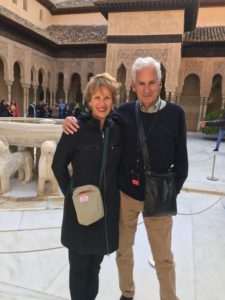Above: Curtain Call for Parsifal at Baden Baden Festspielhaus
Sally and I have just returned to Sydney after our latest music tour, our 10th, that covered fascinating Strasbourg, the superb Easter Festivals in Baden Baden and Aix-en-Provence, and finally Barcelona. Six of us enjoyed a non-musical tour extension to Andalusia, to Seville, Cordoba and Granada, that in some ways, was the biggest eye-opener of all. Every tour gives us all more life-experience, mostly positive, a few things we would like to forget but need to learn from, and much that is really exciting and memorable. This was a big tour with a total of 21 people including our tireless manager Claudia, but it remained a really friendly, intimate group and everyone seemed to have a wonderful time. I think this was partly due to choosing relatively small-scale destinations, away from the ‘big city’ and high tourist places, though Barcelona is certainly a big city and a tourist mecca. What were the forgettable downsides? Well, the weather most of the time was unseasonably chilly and damp, but nobody complained. After all, early spring in Europe is hardly like being on Bondi beach in summer. You want to forget the ghastly experience of getting on and off the TGV in Baden Baden and Aix with a party of 20 people and over 40 pieces of luggage through one door in a minute and a half flat, but unfortunately it was unforgettable, especially the sight of Claudia hurling 20 kg suitcases on to the train like passing Rugby footballs. Never again, we agreed! And the really special moments? For me it was all memorable but what stood out were:
- the totally unexpected performance of Bach’s Matthew Passion in Strasbourg by Benoit Haller’s wonderful La Chapelle Rhénane (we saw a leaflet about it a few hours before the performance)
- Parsifal in Baden Baden on Good Friday with Simon Rattle directing the Berlin Philharmonic
- the fabulous soprano Sandrine Piau in Mozart’s Great C minor Mass
- Flautist Emmanuel Pahud playing Debussy’s Syrinx on a darkened stage in Aix
- the hilarity and bonhomie of the whole group at the farewell dinner in Barcelona
Strasbourg
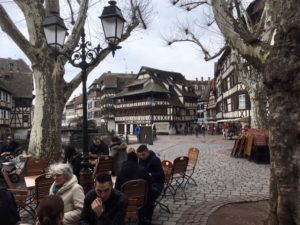
Strasbourg has been cold and mostly wet, but in no way has dampened general enthusiasm for this beautiful and compact city, essentially on an island surrounded by the river and canals. Our hotel Cour de Corbeau is an elegant and ingenious remodelling of about 20 half timbered houses and commercial buildings, all huddled together for hundreds of years and now comprising a beautifully decorated and comfortable complex. Wet weather has compromised our strolling in the city, but the hotel’s comfort has compensated. Our excellent city guide took us more indoors than expected (because of the weather) and the remarkable cathedral in particular, and helped us better understand the complexity of this lovely Franco German city.
Sally says:
Departure day to Strasbourg from Paris. Bus to Gare l’Est, fast speeding TGV to Strasbourg and in less than 3 hours we are sipping tea in the Cour de Corbeau, a 16c medieval building with 21c amenities. A couple more hours and we are now sipping Crement Rosè and eating dinner together as we welcome all of us to the start of Easter Festival tour. 18 people from all backgrounds and places: Qld, ACT, London, NZ, and of course Sydney and Austria. Bravo Antony for once again making this all happen. Tuesday 27 March. Chilly, brisk, crisp morning to explore the city with a local guide The oldest cathedral in Europe taking 4 centuries to build with 320 steps to the roof (which I climbed!) we arrived in time to see the astronomical clock change to demonstrate the passing of time as the figure passes death. Incredible. We finished the tour at Eglise Saint Thomas with an organ built by Silbermann and played by Mozart and Albert Schweitzer in this fine Lutheran church.
Only one performance was scheduled for our three day stay, the Japanese composer Mayazumi’s opera The Golden Pavilion, based on famous novelist Mishima’s 1956 novel about the true story of a disturbed novice monk’s arson of the ancient Kinkaku-ji temple in Kyoto. Presented in the relatively intimate traditional theatre of the Opéra National du Rhin, it was a straightforward production, with simple staging and using lighting to highlight the complexity of the protagonist’s delusional obsessions. Musically stark and uncompromising and much of it composed with twelve tone techniques, the dramatic argument was fairly clear despite the use of two singers to demonstrate (presumably) the contrasting aspects of the protagonist’s personality. Despite the significance of the extraordinary events it dealt with and the serious and high quality performance, I found it ultimately unsatisfying and hard to enjoy. Many of our group disagreed and found it very moving.
For me the most outstanding experience in Strasbourg was the fortuitous opportunity of a performance of JS Bach’s Matthew Passion. On our third morning Sally saw a leaflet advertising the performance that night, our last in Strasbourg, so we quickly put it around amongst the group and most agreed to come. We bought tickets and arrived early as seats were not reserved and found excellent seats in the very large church. La Chapelle Rhénane is one of Europe’s leading baroque choral and orchestral ensembles, so it was a special thrill to stumble on this performance, that turned out to be as good as you could hope for and featured an especially eloquent Evangelist in Daniel Schreiber and the director Benoit Haller’s wife Salome Haller as alto. It was a very moving performance and as we donned our raincoats and umbrellas leaving the church and headed for a cold wet two kilometre walk back to the hotel, it seemed suitably spartan and spiritually drenching.
Baden Baden
I have never been to Baden Baden before and had reservations about a place that was (and pretty well remains) Europe’s leading spa town where all the faded royals and aristocrats of European lineage take the waters, gamble away their dwindling fortunes and stroll through the parks and gardens. However in planning this tour, the opportunity of hearing the Berlin Philharmonic every night (as resident band), was too hard to ignore. As it happens, the town is charming and unpretentious and has gorgeous gardens just beginning to take colour in early spring. Despite the famous Easter Festival and the residency of their great visitor the Berlin Phil and Sir Simon Rattle in his last stint as Musical Director, the town is mercifully free of tourist hordes and to my amazement, there were many empty seats for the concerts in their splendid Festspielhaus. The Festspielhaus has a large modern dual purpose auditorium for concerts and opera seating some 2,500. Very plain and functional in its internal appearance, it has excellent acoustics and is built around an ingenious conversion and addition to the old railway station. We were in Baden Baden four nights and each night we went to a performance of the great orchestra, so cumulatively it was an extraordinary experience. In all its formats the refinement of its playing was outstanding
Sally says:  The Lichtenthaler Allee started life as a narrow medieval track (where an assassination was attempted on Kaiser Wilhelm) and is nowadays a world famous boulevard to walk, cycle or stroll. It features magnificent mature trees about to blossom, ornate bridges over the River Oos, majestic hotels, bathhouses and elegant mansions. We walked to its end and back to enjoy soup in the Cistercian abbey. Our first performance in Baden Baden gave us several of the section principals of the Berlin Philharmonic added to the brilliant young players of the German Youth Orchestra under Simon Rattle. Each year the Philharmonic players tutor the cream of young German musicians selected to come to the Festival. After a terrific performance of Bartok’s early ballet suite The Wooden Prince, two of the young musicians presented Simon Rattle with a gift and between them made a speech of thanks as it was his last time he conducted the orchestra in this capacity. The Festspielhaus organisation has a major commitment to youth music experience and education funded by the creme de la creme of the German corporate sector, and Rattle has been a prime mover of this over the last 20 years.
The Lichtenthaler Allee started life as a narrow medieval track (where an assassination was attempted on Kaiser Wilhelm) and is nowadays a world famous boulevard to walk, cycle or stroll. It features magnificent mature trees about to blossom, ornate bridges over the River Oos, majestic hotels, bathhouses and elegant mansions. We walked to its end and back to enjoy soup in the Cistercian abbey. Our first performance in Baden Baden gave us several of the section principals of the Berlin Philharmonic added to the brilliant young players of the German Youth Orchestra under Simon Rattle. Each year the Philharmonic players tutor the cream of young German musicians selected to come to the Festival. After a terrific performance of Bartok’s early ballet suite The Wooden Prince, two of the young musicians presented Simon Rattle with a gift and between them made a speech of thanks as it was his last time he conducted the orchestra in this capacity. The Festspielhaus organisation has a major commitment to youth music experience and education funded by the creme de la creme of the German corporate sector, and Rattle has been a prime mover of this over the last 20 years.
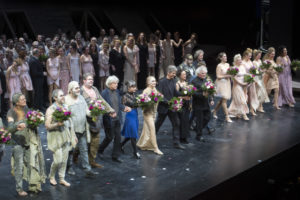
The big number both for the Festival (and for our tour) took place the next night (Good Friday) with a new production of Wagner’s Parsifal. Directed by Dieter Dorn, an older generation ex East German opera and theatre director now in charge of the leading theatre company in Munich, and of course conducted by Simon Rattle, it was played, cast and sung with the utmost refinement. The Gurnemanz of Franz Josef Selig, Amfortas with Gerald Finley and Kundry of Ruxandra Donose were all ideal in their parts; only Stephen Gould’s Parsifal could be bettered, though he sang well, but his awkward large frame and clumsy movement, like a tail wagging St Bernard, made him anything but a golden haired young hero. Many of us didn’t much like the production with the settings consisting entirely of grey pyramidal shapes being pushed around on wheels to form different abstract scenic locations. While I thought there was too much unnecessary pushing around, I felt they worked quite well to form symbolically suitable settings for what are after all very unspecific locations for the slow, unfolding story. The very naturalistic treatment of the individual members of the chorus as real people caught up in the drama was very effective and contrasted with most modern productions where they stand in rows or process in line and their only function is to occupy part of the stage and sing. All told, it was an absorbing and beautiful performance, undistracted by egotistical production values. However, now having seen many productions of Parsifal, I have to admit it unfolds at glacial pace, and for all its wrapt beauty, in this 21st century time-constrained age, it could do with some extensive cuts, especially in the endless Klingsor/ Kundry duet in the 2nd act.
Sally says:
The morning after Parsifal, Sarah, Robin and I soaked naked in the thermal mineral waters of the Friedrichsbad, an elegant bathing complex that originally catered to European aristocracy. We followed a 17-step bathing ritual that included a sequence of hot air baths, steam rooms, showers, pools, and optional massage. We shared a slightly awkward but fabulous experience! We began with a hot shower with huge shower heads to get started. This step is meant to get us clean and also adjusted us to being naked with strangers. After the shower, we took out towel and plastic slippers to a warm-air bath, lying on a towel on the wooden lounge chair. It was so peaceful and I loved the beautiful flower and bird tiles on the wall. Next was a really hot air room with more wooden lounge chairs but I had a hard time staying in this room for more than a minute. Then back to the same showers before a Soap and Brush massage. Lovely! Next we have thermal steam baths. We sit on a little napkin on the marble and enjoy the steam, take another shower before moving to the pools. They began warm and become increasingly cooler – both thermal and whirlpool. The most beautiful and majestic pool was the un-segregated one which we skipped – but it has the best view with a wonderful dome. It’s the area of the spa when we could best imagine the majesty of one of the grandest bathing houses in Europe. 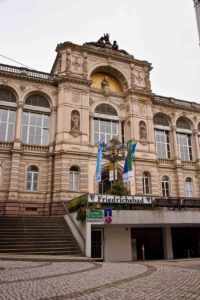 Next was a series of cold and very cold pools – only Robin braved the coldest. The final two rooms are for pure relaxation. In the first, you are quietly guided by an attendant into a dark room filled with raised beds covered in clean sheets and blankets. You are then each individually wrapped into a warm, soft cocoon to relax and sleep. It reminded me a bit of the sleeping pods on the Alien movie! After we broke out of our warm little cocoons, we were then directed to he final Reading room. This is a sunny room with chaise lounges, big warm towels, magazines, and warm tea. Looking back this was such a wonderful experience and it was definitely a highlight of time spent in Baden-Baden. PS. To my great surprise, the next day Antony went off through the same ritual at the Friedrichsbad – on the mixed gender day!
Next was a series of cold and very cold pools – only Robin braved the coldest. The final two rooms are for pure relaxation. In the first, you are quietly guided by an attendant into a dark room filled with raised beds covered in clean sheets and blankets. You are then each individually wrapped into a warm, soft cocoon to relax and sleep. It reminded me a bit of the sleeping pods on the Alien movie! After we broke out of our warm little cocoons, we were then directed to he final Reading room. This is a sunny room with chaise lounges, big warm towels, magazines, and warm tea. Looking back this was such a wonderful experience and it was definitely a highlight of time spent in Baden-Baden. PS. To my great surprise, the next day Antony went off through the same ritual at the Friedrichsbad – on the mixed gender day!
Our next concert offered Simon Rattle a rest day and the orchestra was conducted by another great maestro, Ivan Fischer, founder and artistic director of the superb Budapest Festival Orchestra, and a regular with the Berlin Philharmonic. Young Norwegian violin virtuoso Vilda Frang, tall, blonde and elegantly dressed in ankle length gold, tossed off Bartok’s First Violin Concerto with unruffled poise. An early work, not even published in his lifetime, in its contrasted two movements, it is said to portray his early unrequited love Stefi Geyer, also a violinist, in the dreamy opening movement and his own turbulent self in the second. The second half of the concert was devoted to Mendelssohn’s delectable Overture and Incidental Music to A Midsummer Night’s Dream, the first and arguably the finest musical representation of Shakespeare’s great comedy. Unusually, we were given the full choral version with soloists of the Incidental Music. The delicacy of the Berlin Philharmonic’s playing had to be heard to be believed.
In a perfect conclusion to our musical offering in Baden Baden, Rattle returned to his orchestra with an intriguing but rarely played work, Bernstein’s The Age of Anxiety, a piano concerto in all but name, based on a WH Auden narrative poem about four strangers meeting in a New York at the end of WW II and imagining a new and different post war world. The soloist, the great Polish virtuoso, Krystian Zimerman, had been a friend of Bernstein and has been a champion of the piece during his career. It is a chameleon-like piece going through a complex variety of moods and styles, typical of Bernstein’s eclecticism, but always full of his passion for life and experience. It requires a huge orchestra with large solo parts for many of the musicians and the demands for the pianist are huge, requiring poetic pianissimi through popular song, jazz and complex counterpoint. it was a thrilling performance and our group loved it. The concert ended with a performance of Beethoven’s Eroica symphony that was an eye-opener showing what an amazing experience it can be with a great orchestra taking on one of classical music’s masterpieces. Rattle fined down the orchestra to early 19th century forces of fewer than 50 players. Tempi were brisk and the sound was lean but with perfect intonation and the most delicate sound in soft passages but precise and forceful where the music required it. The experience was not unlike the way Richard Tognetti directs Beethoven symphonies with the ACO with the added refinement of the Berliners and Rattle’s great skill in balancing each section so that no subtlety of expression is lost.
Sally says: Easter Sunday 1 April
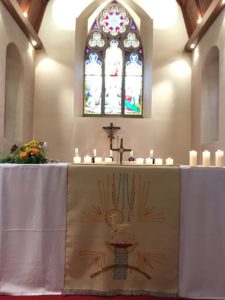
To worship at a beautiful Lutheran church in Baden-Baden was so special. I thought our bath experience was a highlight but the Eucharist celebrated in the German language was even better. Hearing “Come all you people” from the Messiah the sound of “Panis Angelicus” sung from the height of the organ loft and performed by members of the Berlin Philharmonic chorus was beyond anything I had imagined. Walking through the suburban streets of Baden Baden early on Easter morning in the very crisp cold weather having shared the common cup and then sharing coffee and biscuits with parishioners after the service was glorious.
Aix-en-Provence
Travelling from Baden Baden to Aix on the TGV was quite an experience, but not one we would want to repeat. We remain grateful for everyone in the party being so helpful in getting themselves and the luggage on and off the train in breakneck speed during such short stops. But the lesson was well learnt that we should never again board or exit a train with such a large group, unless at the terminus of the route. In particular we are grateful to Chris Smith and Claudia for their efficient organisation. We didn’t arrive at our hotel in Aix until late and sat down for our second group dinner of the tour barely a few minutes before 11. The Aquabella hotel had everything prepared and we had a long table in the dining room entirely to ourselves. A good thing too, as there were 20 ravenous people and their hubbub would have terrified other diners silly enough to be eating at another table.
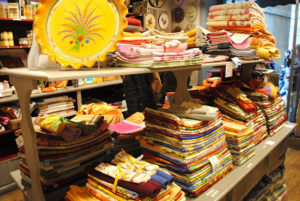
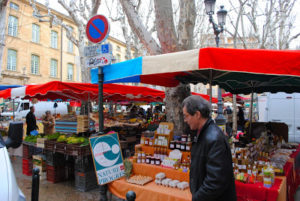
For Sally and me it was a thrill to be in Aix again; such a beautiful small city with the stone of its old buildings glowing pinkish yellow in the sun. After a guided stroll around the city in the morning, our first concert took place at the brand new Darius Milhaud conservatory hall with a superb recital by the great flautist Emmanuel Pahud (having a day off from his regular job at the Berlin Philharmonic) with the Georgian pianist Khatia Buniatishvili. The program included Romantic chamber music pieces by Schumann and Schubert the former arranged for flute and piano, though originally composed for Clarinet. The Schumann Fantasiestueke is in three little movements and was a wonderful piece for Pahud to display his gorgeous rich tone and breath control. The Schubert Variations on the theme of the song Withered Flowers from his Maid of the Mill song cycle was less successful, even though written specifically for the flute this time. The song is sad and mournful but in this piece, after the statement of the melody, it goes through a long sequence of rather cheap and cheerful variations mostly to show off the cleverness of the flautist, spoiling the effect of the original song. After the interval, Pahud really got into his stride with a superbly atmospheric performance of Debussy’s L’apres midi d’un faune, a land mark piece of musical impressionism, usually for orchestra. Then the stage darkened and invisably he played Debussy’s remarkable three minute solo flute piece Syrinx, a quiet, abstract piece of no specific tonality that at the time of composition, was a revelation of flute practice. The effect of these ethereal sounds coming out of the darkened hall was mesmerising. The biggest piece of the program was Franck’s Violin and Piano Sonata, one of the supreme works of the genre, arranged for flute and piano. It was a tour de force and resulted in sustained applause and cheers from the audience.
Sally says:
Our days in Aix have been so enjoyable despite still surprisingly chilly weather. The early Easter this year has the advantage of fewer tourists and we now have glimpses of real warmth emerging in the Provencal deep azure sky. We organised a coach to the Luberon, a mountainous region north of Aix, the real heart of Provence and the location of many picturesque villages. We spent time in three villages, all of which are listed as Plus Beaux Villages de France (Rousillon, Lourmarin and Ansouis). They gave us a taste of the charm of ancient Provence, putting us in touch with a 2000 year old Roman bridge, origins of the Marquis de Sade, lavender fields, the first white asparagus of the season in the foodstalls, and colourful old houses and monuments. All the villages we visited are on the top of hills overlooking valleys and both cultivated and wild fields. The deep red ochre of the hillsides and cliffs of Rousillon viewed from the little terraces at the top of the town were especially spectacular.
Below: Flowers in Ansouis, Luberon village 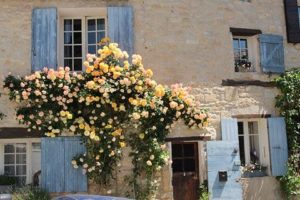
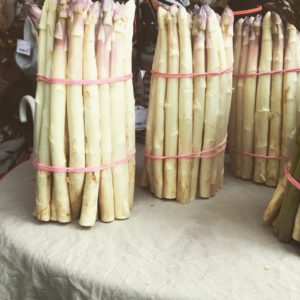
First white asparagus in Roussillon.
Our next concert in Aix was at the Grande Théatre de Provence, a splendid newish hall with good acoustics, with an auditorium similar in style and size to the Llewellyn Hall in Canberra, but also apparently convertible for opera performance, where the opera is performed during the Opera Festival in July each year. We heard the much acclaimed French conductor Laurence Equilbey, a specialist in Classical repertoire of the late 18th and early 19th centuries, who has her own Insula Orchestra and Accentus Choir, performing the “Great” C minor Mass of Mozart, arguably his most profound and substantial choral work, though it was never completed. It was a serious and noble performance, no doubt suitable for Easter, but rather gloomy, and, dare I say, a little dreary for a Festival audience. For me it was enlivened by the sensational singing of French soprano Sandrine Piau, who in a slinky sparkling silver dress, looked as good as she sounded. Sally and I also were struck by the extraordinary hair of the timpanist who looked like he had a large yellow tea cosy plonked on his head.
Sally says:
We had a rendezvous with our Swedish friends Lars Brolin and Barbro in the nearby village St Martin that after so many years is a dream come true. For more than 30 years we’ve heard about the house in Provence that Lars built more or less by hand and now finally we were to see it! We caught a bus, were met by Barbro and given a wonderful lunch in the sunny courtyard with boeuf bourguignon, washed rind cheeses, almond tarte, and a delicious red gignondas rhone wine. To meet Ida, a loving wife and mother of two little girls when last seen as a 9 year old was simply marvellous. Thank you Lars and Barbro.
A visit to Mont Saint Victoire
Once again we return after some years to this spectacular region near to Aix, a favourite place where Cezanne frequently painted (and where he ultimately died) to climb around Mont St Victoire, this time bringing with us the more athletic members of our group. A wonderful day, warm and sunny, but Antony underestimated its length and the extent of the climb. He told us afterwards that on our earlier visit, we had walked in the other direction which was much less steep. So it turned out to be quite exhausting for some of us. However, in the end we all made it through safely and we really did have a magnificent Provencal experience with the deep blue of the sky of blue and fabulous views of the wild maquis bushland free of virtually of any other people.
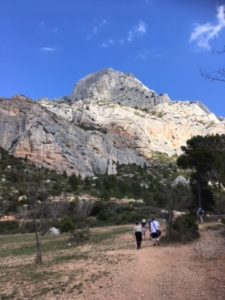 Our final two concerts in Aix were greatly contrasted. At the tiny theatre Jeu de Paumes, we had an intimate recital of mostly French songs by young French mezzo Catherine Trottmann, still in her mid-20s and looking fabulous in a form fitting red dress. On the last night we returned to the Grand Theatre de Provence for an altogether larger-scale all-Brahms concert with Estonian conductor Paavo Jarvi conducting his Bremen Kammerphilharmonie. The Brahms was a thrilling concert with a big dramatic performance of the First symphony concluding the concert. The loud banging of the timpani in the introduction to the first movement seemed musically totally wrong, but there was no denying the power of the whole performance. In the first half we heard yet another brilliant young female musician, in this case 29 year old German violinist, Veronika Eberle, a true virtuoso, playing the Brahms Violin Concerto with enormous authority and not an ounce of ego. Despite Eberle’s playing, I found the song recital at the Jeu de Paumes a more intriguing concert. Though very young, Trottmann is an accomplished artist with an ability to merge her singing with her appearance and personality and offer a total performance. She chose a diverse and challenging program of mostly early 20th century song that happens to be the very best of French song. Her choices of Ravel and Faure and even the Parisian Venezuelan Reynaldo Hahn require experience and sophistication to bring them off. Many of the songs are party pieces for divas like Renee Fleming and Joyce Di Donato and all credit to Ms Trottmann for not holding back. While she will sing this repertoire with more oomph and panache in ten years time, it was a lovely recital and proved she is a singer to watch.
Our final two concerts in Aix were greatly contrasted. At the tiny theatre Jeu de Paumes, we had an intimate recital of mostly French songs by young French mezzo Catherine Trottmann, still in her mid-20s and looking fabulous in a form fitting red dress. On the last night we returned to the Grand Theatre de Provence for an altogether larger-scale all-Brahms concert with Estonian conductor Paavo Jarvi conducting his Bremen Kammerphilharmonie. The Brahms was a thrilling concert with a big dramatic performance of the First symphony concluding the concert. The loud banging of the timpani in the introduction to the first movement seemed musically totally wrong, but there was no denying the power of the whole performance. In the first half we heard yet another brilliant young female musician, in this case 29 year old German violinist, Veronika Eberle, a true virtuoso, playing the Brahms Violin Concerto with enormous authority and not an ounce of ego. Despite Eberle’s playing, I found the song recital at the Jeu de Paumes a more intriguing concert. Though very young, Trottmann is an accomplished artist with an ability to merge her singing with her appearance and personality and offer a total performance. She chose a diverse and challenging program of mostly early 20th century song that happens to be the very best of French song. Her choices of Ravel and Faure and even the Parisian Venezuelan Reynaldo Hahn require experience and sophistication to bring them off. Many of the songs are party pieces for divas like Renee Fleming and Joyce Di Donato and all credit to Ms Trottmann for not holding back. While she will sing this repertoire with more oomph and panache in ten years time, it was a lovely recital and proved she is a singer to watch.
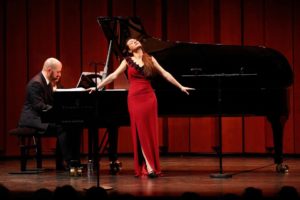
Barcelona
On Saturday 7 April we took a coach all the way south west along the French coast to Barcelona. it took most of the day but was quite relaxing and gave us plenty of time to check in at the Hotel Barcelo Raval and find something to eat for dinner. The hotel is new and very different from what we are used to. A multi-level cylinder covered in grey metal shutters, and emitting a blueish glow, it looks more like a space shuttle preparing to take off than a hotel. The ground floor has all the public facilities, like dining, reception, bar and lounge in an open area. The roof gives fabulous views of the city through 180 degrees, and the rooms, shaped like wedges, are set up unlike anything you have experienced in a hotel before. I liked it, but some found it disconcerting and at least one remarked that they would never set foot in it again.
On the Sunday morning we had an early 11 am concert in the relatively new performing arts centre, L’Auditori, a large plain and functional looking multi purpose building, and the home of the Barcelona Symphony Orchestra. The concert was part of a series of concerts for emerging soloists and the demanding program featured two concertos, Shostakovich’s Cello Concerto no 1 with a young British cellist and Prokofiev Piano Concerto No 1 wirh a young French pianist, plus Respighi’s The Fountains of Rome. The cellist Sheku Kanneh-Mason, was only 19 but gave a terrific performance. The Prokofiev suffered greatly from a terribly muddy acoustic in the hall and was virtually inaudible. Such an inadequate acoustic in such an expensive new complex is disgraceful.
It was a big day for us as most of us attended a concert performance of Verdi’s early opera Attila at the great opera house Gran Teatre del Liceu. In advance I wondered whether a concert performance of a little known opera with a cast of sub-international names was worth attending. How wrong I was! It turned out to be one of the highlights of the tour. We had splendid seats in the stalls and the soloists were lined up across the front of the stage with the orchestra on stage behind them and the chorus at the back. The performance was sensational, due in part to our close proximity to the singers, but also because all had terrific big voices, and freed from dealing with stagecraft and movements, could stand and belt it out. The Attila, in particular, Russian bass Ildar Abdrazakov had a fantastic stentorian voice, well matched by Italian dramatic soprano Anna Pirozzi, who marched on stage early in the piece in a most unflattering floral gown, opened her mouth and nearly blew us out of our seats by the sheer volume and brilliance of her sound. In the interval we repaired to the grandest and most elaborate gold decorated lounge for drinks, enormous and no doubt created at the height of early 20th century grandeur. After the opera we walked out along La Rambla stunned by the performance, hurrying back to our nearby hotel in the rain!
Barcelona is a truly fabulous city, and even though much of it appears down at heel and in need of some paint, the great squares, gardens and boulevards speak of a city of power and elegance. During our guided city walk, some of us talked to the guide about the continuing independence crisis for Catalonia. It seems to have become a most unsatisfactory deadlock with the central government in Madrid refusing to compromise and many of the leaders of the rebel Catalonian government either in prison or stuck abroad and unable to return. Our guide told us the intransigence of both sides is starting to irritate the people, most of whom want a settlement of some sort, though this seems to be a long way off. Two weeks after our tour we spent a few days in Basque country in Bilbao and San Sebastian (now called Donostia – the Basque name for the city). At the other end of the Pyrenees, the Basques have much more sensibly given up their previously lethal demands for independence and have settled for a swathe of special advantages from Madrid. The obvious prosperity of the Basque country seems to show pretty clearly the folly of Catalonian independence demands.
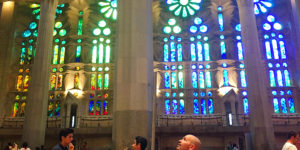
Our visit to Sagrada Familia, the great church and masterpiece of Antonio Gaudi, was overwhelming. Even 80 years after it was started, it is still uncompleted, though modern building technology will allow Gaudi’s almost impossible ideas to be realised and completed, hopefully by 2026. I found walking into it and being greeted by the riot of colour from its stained glass windows an extraordinary and very emotional experience. Not only the colours from the windows’ mostly abstract designs, but the profusion of asymmetric columns, arches, chapels, and vaults gives the interior a look of a gigantic spiritual garden full of enormous exotic plants and flowers. The exterior is just as fantastically extravagant and the profusion of slender curving towers, now surrounded by thin yellow cranes poking high in the sky gives a bizarre extra terrestrial look. I watched one of the cranes lifting a rosette for one of the towers being lifted across the church into the sky seemingly miles above the earth.
Later we were taken to Parc Guell in the hills on the outskirts of the city, a huge public park completely designed by Gaudi and replete with his most fantastic shapes, colours and designs for a public place to be enjoyed by everyone. The overall impression is that you have landed up in another world of huge multi-coloured magic mushrooms. Gaudi’s house is on the edge of the park and it is wonderful to see the adoration by everyone who sees it of this strange, miraculous reclusive artist.
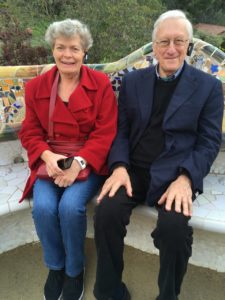
In the evening we enjoyed our last tour performance. Fittingly, it took place at the fabulous Catalonian art nouveau extravaganza of a concert hall Palau de la Musica, completing a day of amazing visual, spatial experiences. We crowded in to the Palau de la Musica finding it relatively small compared to most symphonic halls, but the great art nouveau glass ceiling and the incredible detail of the high relief decoration on the walls, the ceiling, in the foyers, on the stairs and in every nook and cranny were inexhaustible. I found that an almost life-size coloured plaster horse a metre above my seat hanging from the ceiling.
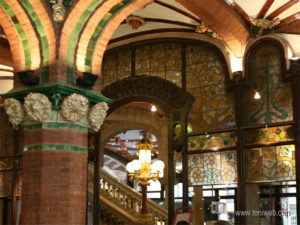
The performance by the top orchestra from Florence, Orchestra del Maggio Musicale Fiorentino conducted by Vladimir Ashkenazy of the Beethoven 7th and Tchaikovsky 4th symphonies was almost secondary to the splendour of the venue. However we all loved both the place and the performance and it was a real high note to end the music of the tour, especially the sight and sound of the cymbals player accidentally dropping his cymbal on the floor. Personally, I enjoyed the Beethoven more than I did Rattle’s performance of the Eroica in Baden Baden with the Berlin Philharmonic. Ashkenzy prefers a more traditional 20th century style of playing Beethoven with steady tempi and more generous phrasing, rather than the swift and clipped style that Rattle gave us and is so prevalent today.
Our last day saw us enjoying the Miro and Picasso museums in Barcelona. The Picasso is devoted largely to his early works and obviously defers to the major museum for the great artist in Madrid. A couple of weeks later Sally and I went to his museum in Paris which was showing a remarkable special exhibition of the origins and effects of the famous Guernica painting installed in Madrid. The Paris exhibition was fascinating in giving a detailed analysis of the profusion of cultural and personal references in Guernica and how they developed in the many stages and versions of the painting before he settled on the finished version. For someone like me who had always thought it was a painting done in the white heat of outrage over the Spanish civil war, it was a revelation to learn how much thought he had put into it over a long period. Somehow it had become an amalgam of the deep personal and cultural influences of his life that had been gathered together to focus on the political cruelties of that age.
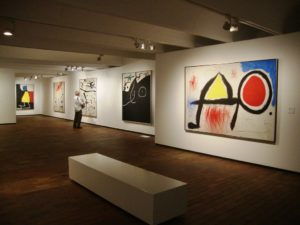
We reached the Miro museum in the hills on the edge of Barcelona by funicular. A beautifully designed gallery, largely defined by his requirements, it is an eloquent exposition of the great breadth of his artistic passions.
We were then scheduled to walk up to Montjuic Park overlooking the whole of the city but most of us decided to give it a miss and save ourselves for the farewell dinner. This took place in the restaurant across the street form the Barcelo Raval hotel. Sally decided to mix everyone up by putting place names on the table for everyone, and when we arrived the restaurant had set up a private room in most elegant fashion. I have to say we have hosted many tour farewell dinners before, but without doubt this was easily the best. The place looked lovely, the food was beautifully presented, tasty and unusual, and the wine flowed without stinting. The conviviality amongst the group was infectious and the noise level rose throughout the evening until it only be described as a din.
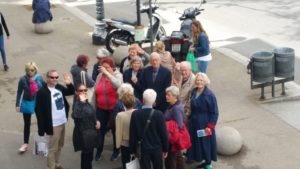
Andalusia
On the morning of 11 April we all departed from Barcelona, six of us to take the optional four day tour extension to Andalusia, while our tour manager Claudia and the rest of the party returned home or took off to other places around Europe. The six Andalusian enthusiasts flew to Seville and settled in a comfortable and very Spanish looking hotel called Fernando III, smack in the middle of the old town of Seville. While the tour’s scheduled musical performances finished in Barcelona, I was keen to experience an evening of flamenco seeing Seville is a centre of this art form. We found a flamenco lounge in a narrow old street not far from the hotel and enjoyed what seemed to be a very professional and authentic performance. It was very informal and seemed to be led by a pudgy middle aged man who played guitar and sang. Three other younger singing guitarists alternated with him both as soloists and in ensemble. They all sang with an unusual edgy guttural sound that is clearly what is required. They accompanied three female and one male dancers, who danced mostly as solos, but occasionally danced together. Their colourful traditional costumes and carefully choreographed movements were delightful. The whole thing was very relaxed with the artists laughing and chatting to each other between numbers, and sitting in the audience when not performing. No food was served but we were all given a drink before the performance and could order more if we wanted. Altogether a terrific evening.
The next day was cold and wet, not what we expected of Andalusia, and we were not pleased that we had to walk half way across the city in the rain to meet our guide Teresa, only for her to take us most of the way back to start the visit to the Real Alcazar and the Cathedral. The cathedral is immense, the largest Gothic cathedral in the world, surpassed in size only by St Peter’s in Rome and St Paul’s in London. It is gloomy (maybe because it was a wet day) but its sheer size gives it a dark magnificence, like a half lit Rembrandt painting. The main chapel (Capilla Mayor) is extraordinary with the retable above and around the high altar of astonishing size and golden detail, though through the screen before it and in the semi-darkness, the detail of the 45 separate high relief biblical scenes, was not easy to make out. However discreet search lights wash over the whole area and help the viewer to see more detail of the exquisite carvings. From outside, the Cathedral is so large it looks more like a city in itself. Its profusion of Gothic towers and decoration is overlooked by the Giralda Tower, the one remaining element of the Moorish mosque that was built in the 11th century. Seville was recaptured by Ferdinand III in 1248 and over the next two centuries this mighty cathedral was built. The guide then took us to the Real (Royal) Alcazar, the palace built around and replacing the Moorish palace. When Ferdinand III captured Seville in 1248, he and his notable successor Pedro I set out to rebuild the palace and what now stands of the Alcazar is their work and is regarded as the finest example of Mudejar architecture. The whole place takes a huge entire block in the middle of the city and is full of splendid buildings and gardens. Because of the rain we spent most of the visit in the interior which features the typical horse shoe arches with their incredibly slender pillars and elaborate Moorish geometric decorations on the walls. Most of the walls, especially in the lower sections are covered in patterned ceramic tiles of many colours. 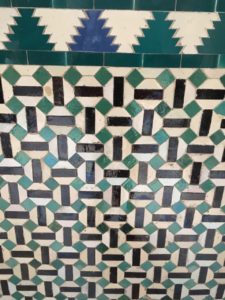
We caught a mini-bus the following morning to Cordoba to see the great mosque Mezquita and then on to Granada; a long day but it proved to be well worth it. Cordoba is 200 kilometres north east of Seville on the banks of the huge Guadalquivir river. 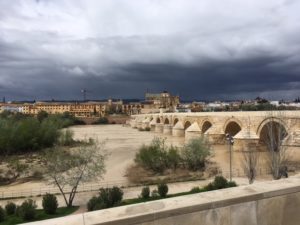
The view of the massive Mezquita mosque from the southern side of the river across the ancient Roman bridge is a marvellous sight. The Mezquita is the largest mosque in the world built by the caliph Abd ar-Rahman III in the 9th and 10th centuries. From outside, a huge rectangular sandstone fortress on the north bank of the river, its appearance gives no sense of the phenomenal interior. It consists of no less than 18 parallel naves separated by endless rows of magnificent double semi-circular arches supported between two columns (one arch on top of the other). All the arches feature pink and cream or white zig zag patterns. The sheer spectacle and grandeur of these massive spaces with the hundreds of arches in rows has to be seen to be believed.
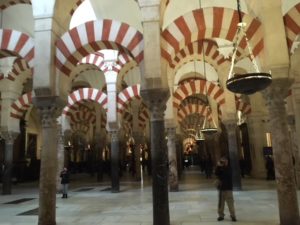
In the middle of the mosque is another incredible sight. After Cordoba fell to the Christians in the 13th century, three centuries later a complete Christian cathedral in Gothic style was built in the middle of the Mezquita by demolishing a central section of the interior Muslim arches. The cathedral itself is a splendid medieval church of great size and presence. What an amazing place the Mezquita is! 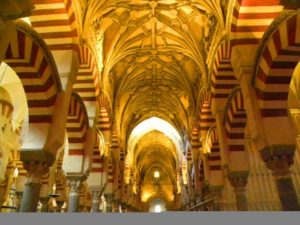
After we crossed the Roman bridge over the Guadalquivir, we made no further attempt to explore Cordoba, but took the mini-bus on to Granada. Approaching Granada, with its hills framing it, I thought I could identify the long anticipated Alhambra nestling long, flat and reddish grey in the hills above the city. As we got closer, I saw I was right. We arrived in the centre of the city to the Melia hotel, looking smart and elegant and checked in. In actuality it wasn’t as good as the foyer promised and Sally had to do a number on the elderly desk manager when she discovered our room was not to her liking, but then I have become used to this charade. We ate at a very traditional Andalusian restaurant that night that had plaques on the wall about the famous artists and politicians who had eaten there including Lorca and Picasso.
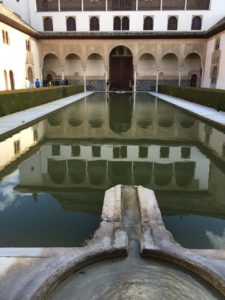
The Alhambra was the last big experience of our tour and it was well worth the wait. Claudia had booked us to start late to avoid the crowds, an excellent idea and the six of us took two taxis the quite short distance up the hills behind the city to the entrance, arriving at about 4.30. We met our very knowledgeable guide, who explained the background to the complex as we wandered through the beautiful gardens at the top of the site with superb views down over the city and along the ridge towards the main palace. The gardens feature long cultivated walk ways lined with cypress pines flanking long shallow pools with lush ornamented flower gardens alongside.You enter and exit open and closed pleasure pavilions, lined with elaborate geometric patterns on the walls, many by means of ceramic wall tiles. One exits on to a 50 metre long waterway like an ancient long slender infinity pool, except the whole enclosure is bounded at each end with intricately decorated walls with slender arches. 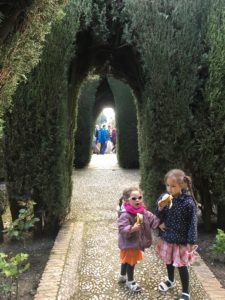 Then we move into a series of ever finer and more spectacular halls with colourful geometric wall and floor patterns and delicate arches. One of the loveliest features is the way you come across intimate vistas from windows, secluded balconies, or simply slits in the walls. Another special charm is the fact it is located high in the hills over the plain and the city, and every aspect has beautiful views. No wonder the Alhambra is one of the most beloved and visited cultural sites in the world. Our visit lasted three hours but not a minute was wasted. It was the perfect way to finish our tour. The next morning we went our various ways, Sally and I to Lisbon for a short Portuguese holiday, our first visit to the country.
Then we move into a series of ever finer and more spectacular halls with colourful geometric wall and floor patterns and delicate arches. One of the loveliest features is the way you come across intimate vistas from windows, secluded balconies, or simply slits in the walls. Another special charm is the fact it is located high in the hills over the plain and the city, and every aspect has beautiful views. No wonder the Alhambra is one of the most beloved and visited cultural sites in the world. Our visit lasted three hours but not a minute was wasted. It was the perfect way to finish our tour. The next morning we went our various ways, Sally and I to Lisbon for a short Portuguese holiday, our first visit to the country.
Sally says:
In Seville, Teresa our guide took us to the Cathedral of Santa Maria – ‘so exquisite no other would compare’ per a 1401 quote. I have to say that despite seeing magnificent Notre Dame, the English, European and even the Washington Cathedral and only 2 days ago Gaudi’s Sagrada Familia in Barcelona – this cathedral had me utterly gasping. Something about the transition from Moorish to Christian maybe or just the colossal size and wealth of the alter, huge roofed domes and columns that tower over us had me incredulous. It’s been plonked into the hollowed out area of the Mosque. However it was a pity it rained because Seville is the proud capital city of Andalusia and it was difficult to gain the extent of its charms. Teresa told us about the making of sherry, the orange trees, flamenco and the different Arabic influences and traditions. And of course the great changes made by Ferdinand III and Isabella. The other major site were some of the rooms of the royal residence and palace (Reale Alcázares). It is here that complexity of the past is revealed and the origins dating back to the early days of Arab rule. I wasn’t sure if I might’ve been looking at the Taj Mahal! How magnificent building of many aspects of his Mudejar tradition blending with Spanish and Christian design features, even a Star of David! I wanted to go to the old Jewish quarter in the evening as I had been advised to do so but the weather really prevented us doing that. I particularly wanted to find out a bit more about the Inquisition.
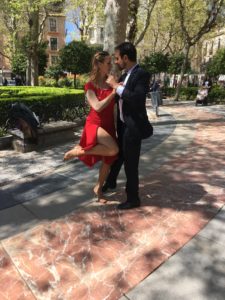
Alhambra
The tour of the Alhambra included the beautiful Gardens followed by the three Palaces. The garden beds are changed every two months so they are always in bloom. They are truly beautiful. Gorgeous ancient cypresses and of course numerous pomegranates, the emblem of Granada. Our guide told us the pomegranate has 613 seeds and the shape of the fruit can be found in the stucco walls of the design in the palaces. He also told us the apparently geometric wall and floor patterns are in symmetry to indicate perfection. Allah is not allowed to be visually represented thus perfection is in symmetry! The extensive long Moorish history, the rule of the Catholic kings, the effect of the discovery of the new world and Christopher Columbus, Peter the Cruel, Phillip etc etc all goes into the melting pot of this marvellous Iberian history of which I and many of us educated in post-Renaissance history are foolishly ignorant. One fact I had never heard was that the Alhambra fell into decline for a long period until the US Ambassador Washington Irving came in the 1890’s. It was then that he heard the ancient stories and tales and so wrote a collection called: Tales of the Alhambra. It was for this reason that it was then restored and returned to its rightful glory.
